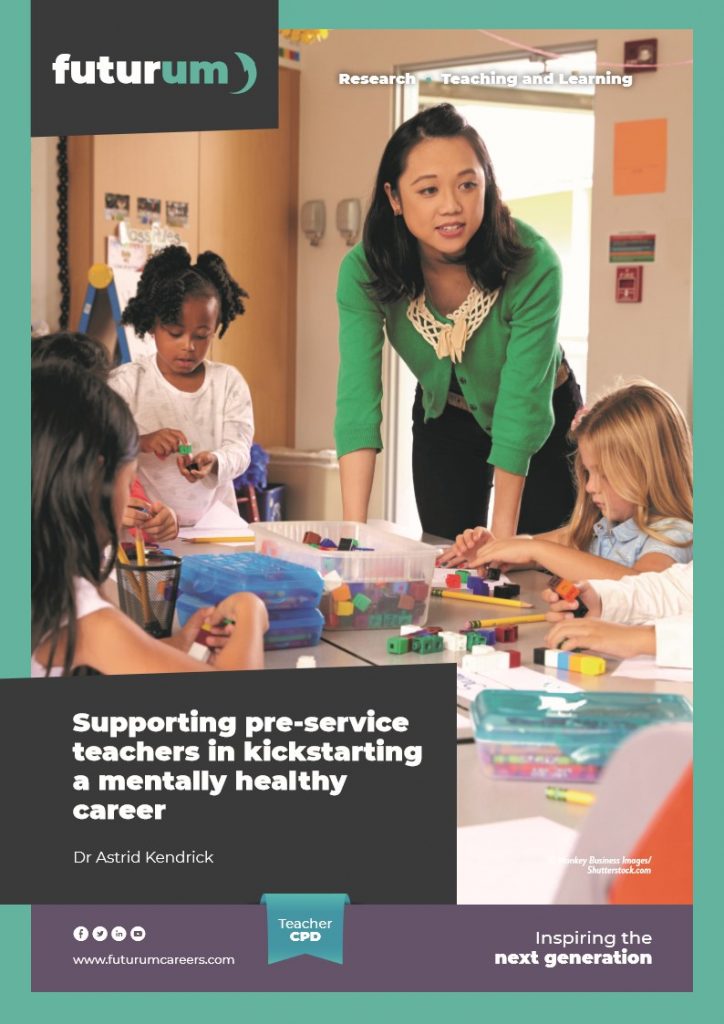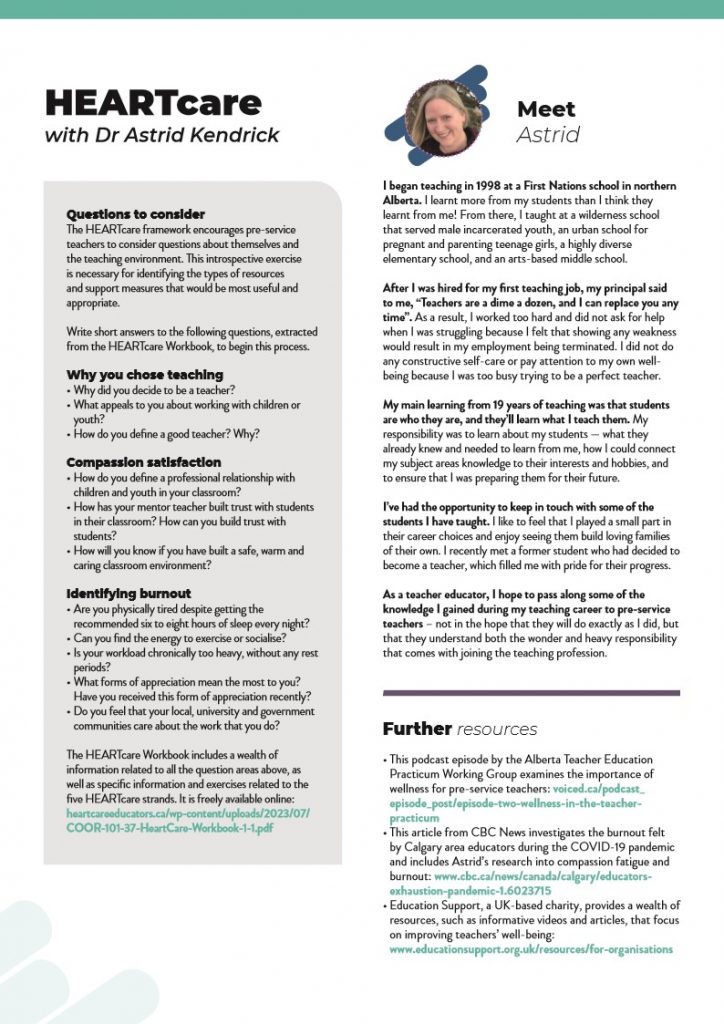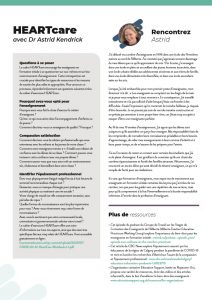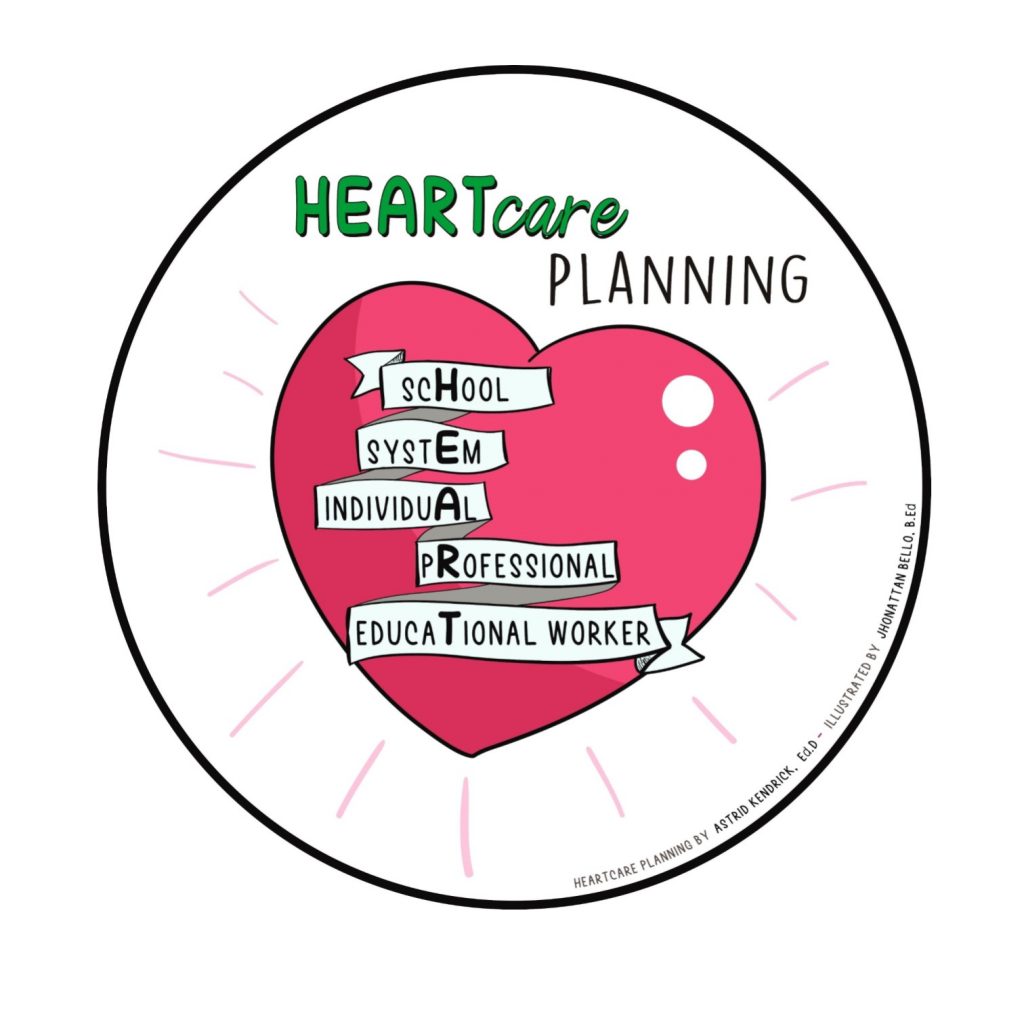Supporting pre-service teachers in kickstarting a mentally healthy career
Teaching is a highly rewarding but also highly challenging career. Ensuring that pre-service teachers avoid compassion fatigue and burnout, both through their own self-care and through accessing support resources, is the mission of HEARTcare. Dr Astrid Kendrick, of the University of Calgary in Canada, believes that the HEARTcare resources that she helped formulate can set pre-service teachers on the path to a truly rewarding teaching career.
 Dr Astrid Kendrick, Ed.D
Dr Astrid Kendrick, Ed.D
Director, Field Experience (Community-based) Academic Director, Outreach and Professional Learning, Centre for Well-Being and Assistant Professor, University of Calgary, Canada
Field of research: Education
Research project: Creating and collecting resources to support pre-service teachers’ well-being in the workplace
Funders: Social Sciences and Humanities Council of Canada (SSHRC), Alberta Teachers Association, Alberta School Employee Benefits Plan (ASEBP)
Teaching is one of the oldest professions and often seen as a vocational calling, preparing the next generation to find their place in the adult world and contribute to societal progression. Teaching also has the potential to be a taxing occupation. “While teaching can be a highly rewarding career, working with children and youth can be very stressful and difficult at times,” says Dr Astrid Kendrick of the University of Calgary. “In order to create a safe, warm and caring school environment, teachers need to express genuine care and develop effective relationships with their students.” Astrid studies the interplay between teacher and student well-being, and how teachers can be supported at every stage of their career – from preservice to retirement.
A teacher’s role
While teaching at its most fundamental level is about the sharing of subject-specific knowledge, a teacher’s duties go far further. “While teachers play an integral role in developing a child’s intellectual abilities, they must also be attuned to all six dimensions of health for the students,” says Astrid. “This includes their social, mental, emotional, intellectual, environmental and physical health.” Incorporating such a holistic approach into the classroom involves teachers using the curriculum to create opportunities for students to develop their interpersonal relationships, regulate their emotions, make healthy lifestyle choices, and be stewards of their environment.
Accounting for all these factors in the classroom is a big ask for teachers, but Astrid believes it is a vital part of facilitating students’ development. “Teachers create the classroom conditions that can help their students flourish – or falter,” she says. “For example, attuning to children’s mental health might involve using assessment techniques that, while rigorous, do not unnecessarily push students’ stress levels beyond their ability to cope.” To put such considerations into practice, students could sit several lower-stakes exams spread throughout the year, rather than one high-stakes exam at the year end, for instance.
The emotional demands
As part of ongoing research, Astrid ran a research study that asked teachers to list the three emotions they display most commonly at work, and the three emotions they are most likely to conceal. “Overwhelmingly, survey respondents selected ‘joyful’, ‘cheerful’, ‘energetic’ and ‘mildly frustrated’ to describe how they felt they should appear at work,” she says. “Anger, sadness and frustration were the emotions they hide at work.” Participants’ principal reasoning for concealing these emotions was to ensure that classroom environments felt safe and caring for students.
This highlights the emotional labour faced by teachers: suppressing their own emotions to help students’ health. “The term ‘superficial acting’, coined in 1983 by Arlie Hochschild1, describes when teachers feel compelled to display emotions that they don’t feel – to pretend they are joyful or energetic, for instance,” says Astrid. “Ongoing superficial acting is associated with emotional burnout and disassociation.” Over time, teachers may disassociate their actual self from their professional self to act in a way they feel is acceptable in the classroom.
Despite these challenges, respondents also highlighted that these displays of positive emotions were normally genuine. “They often felt joy when a lesson went well, the students learned the content, and they received acknowledgement and validation from the school or government inspectors,” explains Astrid. “These experiences sustained them through difficult times, providing the drive to continue teaching.” Yet, such positive experiences were in worryingly short supply. Respondents suggested that difficult times were outnumbering the positive times, leading to a growing sense of suffering among teachers.
First experiences
As part of their training, pre-service teachers engage in classroom teaching practicums. Typically, these practicum placements are their first experience of teaching first-hand and are formative experiences in shaping their approach to teaching and career aspirations. “Before entering the teaching profession, people rarely understand the background work and ongoing professional learning necessary to maintain an engaging, safe and caring classroom environment,” says Astrid. This behind-the-scenes work constitutes a major part of a teacher’s workload, but Astrid believes that pre-service teachers may have misconceptions about what it entails. “For instance, pre-service teachers may think that teaching is an ideal profession for a parent, as they will have the same holiday breaks as their children,” she says. “However, any additional caregiver responsibilities add to one’s emotional and mental workload, which can make providing emotional support to students even more difficult.” Astrid also highlights the amount of planning necessary for a career in teaching – not just daily lesson plans, but also yearly, weekly and back-up plans to support student learning through unexpected changes or incidents common in schools.
Compassion satisfaction, stress and fatigue
Compassion involves being able to understand and empathise with the feelings of others and acting to help relieve the suffering that others feel. This action can bring its own emotional benefits. “A person experiences compassion satisfaction when they effectively relieve suffering in another person,” says Astrid. “For teachers, this satisfaction is built through their connection to students, feeling that their teaching is important and valued, and teaching in a subject area in which they have expertise.”
However, teachers do not always feel this sense of satisfaction. “Creating a compassionate classroom culture requires that teachers are able to notice, feel and act to relieve perceived suffering of their students,” says Astrid. “Many students face mental health and social problems that go well beyond typical teacher training and their scope of practice.” If teachers feel unable to help relieve students’ suffering, they can experience compassion stress, a type of secondary traumatic stress. Depending on the nature of the suffering of the student, a teacher may experience compassion fatigue, which can interfere with their own feelings of empathy to others’ suffering or apathy to students’ health needs.
Compassion stress and compassion fatigue are occupational hazards experienced by those working directly with people experiencing a crisis or traumatic event. “In educational settings, crisis work can involve leading students or colleagues through a distressing event such as a fire, violent classroom incident, or a pandemic,” says Astrid. “Trauma work is provided when a teacher listens to a student or colleague who speaks about a traumatic event – a bereavement, or neglect or abuse, for instance.” Unlike other frontline professionals, such as social workers or healthcare personnel, teachers are not specifically trained to provide crisis or trauma work, yet both are frequent occurrences within schools. This highlights the critical need to equip teachers with the tools to support students and their colleagues while simultaneously looking after their own health and well-being.
The danger of burnout
Reference
https://doi.org/10.33424/FUTURUM465
Practicum placements are formative experiences in shaping a pre-service teacher’s approach to teaching and their career aspirations.
Sustained heavy workloads – in volume and emotional burden – can lead to burnout. The World Health Organization identifies the categories of symptoms as physical and mental exhaustion, cynicism and lack of acknowledgement, and depersonalisation2. “In education, depersonalisation has the greatest impact on the well-being of children and youth,” says Astrid. “They will feel the effects of being in a classroom with a teacher who is unable to show they care about them as individuals needing support and compassion.”
Astrid’s research suggests that mid- and late-career teachers feel the symptoms of burnout and compassion fatigue the most intensely. “Mid- and late-term teachers are vital to the profession as they provide mentorship, leadership and institutional memory for their colleagues and communities,” explains Astrid. “However, survey participants in these categories suggested they felt ignored and were not getting the support they needed to stay in education.” Losing these experienced teachers has many negative consequences including disrupting continuity and stability for schools and students. Pre-service teachers also lose access to valuable insights and effective teaching practices from long-serving staff members. Teachers need to be supported at every stage of their career, creating an environment where compassion fatigue and burnout are minimised and the positive aspects of teaching careers, such as compassion satisfaction, are made more possible.
1. (https://www.ucpress.edu/book/9780520272941/the-managed-heart
HEARTcare planning
HEARTcare planning is a framework to help pre-service teachers understand and find the resources available to helpthem tackle the challenges that a career in teaching can entail – and support their students in the process. “HEARTcare planning helps individuals identify and access interventions during times of stress and distress,” she says. “It consists of five main elements that, together, provide a framework to promote well-being for educational workers.”
The five elements are:
scHool – workplace and relationship
systEm – pedagogy, responsibility and policy
individuAl – personal learning, self-care and identity
pRofessional – expert help
educaTional worker – community and unique work
scHool
Every school has a unique and specific teaching and learning culture. “In general, a psychologically safe workplace promotes a sense of belonging for all community members, has open and transparent communication that gives space for respectful disagreement and collaboration, and respects its most valuable asset: teacher, student and leadership time,” says Astrid. Prioritising collective well-being and collective compassion is at the heart of establishing a positive school culture.
Pre-service teachers can offer a unique perspective on school cultures, entering as an outsider with a fresh and potentially unbiased approach to teaching. “However, pre-service teachers have little influence on overall school culture, as they are only part of the community for a matter of weeks and will be assessed by their partner teacher and principal at that school.” This is not an ideal context for challenging established cultures, as it can risk their relationships with staff and affect their assessment success. Generally, pre-service teachers also lack the knowledge of what changes would improve the school’s culture.
HEARTcare planning suggests a more introspective approach when faced with a non-ideal school culture. “Preservice teachers can reflect on what they perceive as problematic practices in their practicum school and consider how their actions might help create a more productive environment,” Astrid says. She recommends that pre-service teachers focus on struggling students, and what resources are available to help them support their students. She also suggests looking at stress management techniques used by their mentor teachers and accessing the best support and professional development opportunities. “A pre-service teacher could share learning opportunities and resources for teacher well-being with their partner teacher or principal, being constructive rather than critical,” says Astrid.
systEm
A school’s environment is also heavily influenced by its place in the wider social and governmental system, including the rules and regulations that are placed on it. “Pre-service teachers should spend time reading the local and national governmental legislation that impacts their work,” says Astrid. “The expected scope of work, conduct and competence required of teachers is very clearly defined in both legislative and case law.”
The HEARTcare planning framework recommends that pre-service teachers become familiar with relevant teacher organisations and unions that can offer support and help clarify teachers’ responsibilities. “Additionally, their practicum supervisors, university professors and student associations can provide immediate responses to questions about the educational system,” says Astrid.
individuAl
Even with the most rigorous support system in place, individuals need the agency to do what they need to do to feel well and cope with stress. “Time is by far the most valuable resource, so pre-service teachers should identify the priorities for their time,” says Astrid. “Setting time aside each day to do an activity that supports one of the six dimensions of health can help them manage their workplace stresses more effectively.” Implementing HEARTcare involves setting a daily goal that can be achieved within 10 to 20 minutes, and to adjust this goal if it becomes impractical. “Healthy habits are often built incrementally over time, so starting with small daily goals is better than setting a big, long-term goal,” says Astrid.
Self-care practices can include meal planning, scheduled physical activity, listening to relaxing music on the commute, and spending time with other pre-service teachers to build community. “Because each person’s self-care needs are different, there is a wide range of resources to explore,” says Astrid. “We recommend that pre-service teachers seek out evidence-based and research-tested resources and supports, rather than trendy or expensive ‘wellness’ activities that are not proven to actually reduce stress.”
pRofessional
Seeking professional support is an important part of any career. “Pre-service teachers should ask their university instructors and other advisors for information about available well-being programmes and services,” says Astrid. “They should also investigate if there are benefit plans available to them.” It may be that therapeutic intervention is required, and many therapists, psychologists and psychiatrists charge patients according to their income.
Astrid also highlights that proactively researching options for benefits and healthcare ahead of needing them can prove prudent. “The worst time to navigate the often-complex healthcare and benefits systems is when a person is already in a state of distress,” she says. “Having a prior professional connection removes the stress of seeking help.” Furthermore, visiting professionals before problems magnify can help to identify and address sources of distress before they become a major issue. “For teachers to maintain a safe and caring classroom, they cannot wait to access help until their symptoms are severe and overwhelming their ability to cope,” says Astrid.
educaTional worker
Working in education can be simultaneously fulfilling and depleting, with both rewards and challenges impacting the daily life of a teacher. “Recognising that pain and suffering exists within their own and students’ lives, and not trying to create a toxically positive classroom by avoiding or ignoring the challenges these present, is an attribute of compassionate and caring educators,” says Astrid. “Through this acknowledgement, the teacher has the agency to potentially change the immediate conditions related to the problem.”
Pre-service teachers may not have much immediate authority in terms of facilitating large-scale improvements, so Astrid advocates for looking at the long-term. “Schools and classrooms are complex and constantly changing environments, and systemic problems can feel overwhelming or impossible for a single person to influence, especially for pre-service teachers,” she says. “But, being at the start of their career, pre-service teachers have time to make the changes necessary to make education better for their future students.”
HEARTcare goals can include investigating areas for collective action, such as participating in curriculum reviews, joining local teacher organisations, and advocating for equity and funding for public education. “Simple actions or one-time advocacy is rarely enough to make largescale or sustainable changes,” says Astrid.
“Progress involves sustained and passionate efforts by multiple interested actors, such as government officials, parents and business interests, to take hold.”
At the heart of these efforts is humility from early-career teachers, to remain open to learning more about the structures surrounding teaching, and hard-won resilience from mid-late career teachers, who continue to show up and care for their students and colleagues. “Feedback, growth and learning are at the centre of moving from a pre-service to an in-service teacher,” says Astrid. “The pre-service stage is one of the few times that someone has access to mentoring from an experienced professional.” Pre-service teachers are, by definition, still studying – and there is always more to learn about how to be effective and engaging in one’s teaching.
Do you have a question for Astrid?
Write it in the comments box below and Astrid will get back to you. (Remember, researchers are very busy people, so you may have to wait a few days.)

Learn about the importance of self-referencing as a learning technique:
www.futurumcareers.com/the-importance-of-self-referencing-as-a-learning-technique














0 Comments